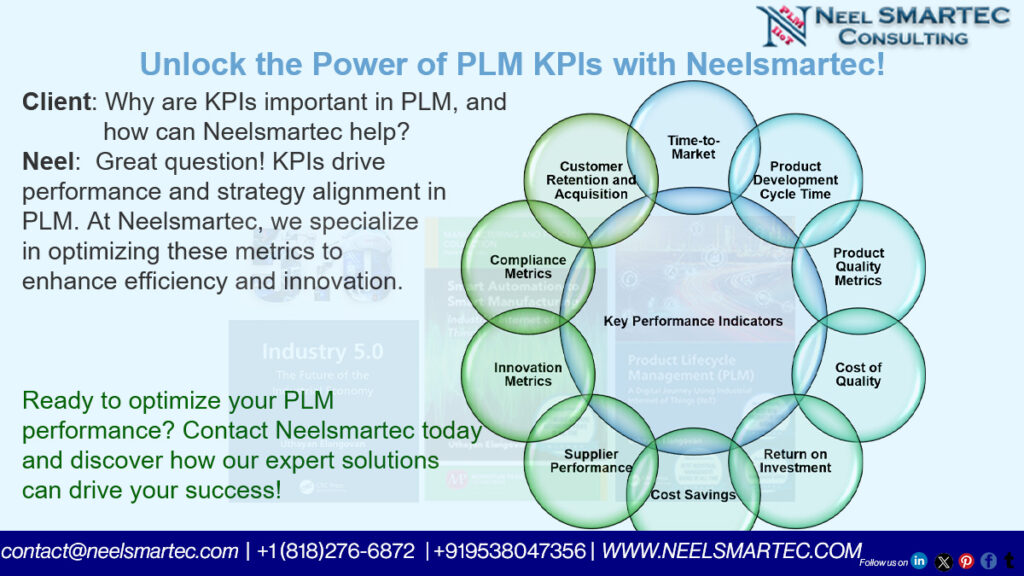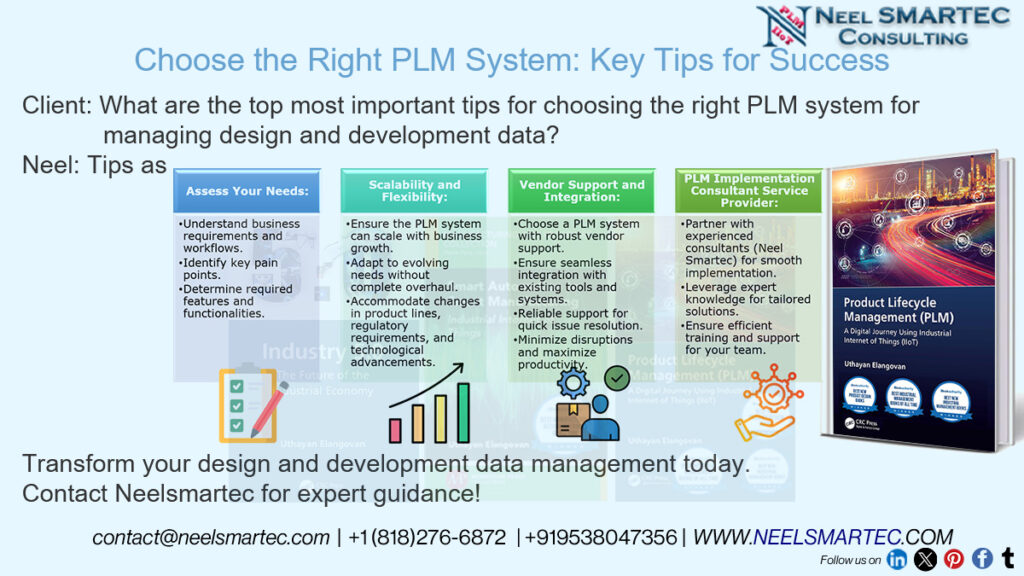
Explore the Why and Why Not of PLM from Neelsmartec. Understand the benefits and challenges of PLM for your business success.
Introduction
In an era where businesses face relentless competition and rapid technological advancements, managing the entire product lifecycle efficiently is crucial. Product Lifecycle Management (PLM) systems offer a strategic advantage by providing a holistic approach to managing a product from conception to end-of-life. This article explores the fundamental aspects of PLM, its benefits, challenges, and real-world successes, highlighting how leveraging PLM can unlock new business opportunities.
What is PLM and Why is it Important?
PLM is a comprehensive process that integrates people, processes, business systems, and information to manage a product’s lifecycle. It encompasses all stages, from initial concept through design, manufacturing, service, and disposal.
PLM systems are vital for:
- Centralized Data Management: Ensures all stakeholders have access to consistent, up-to-date information.
- Streamlined Processes: Facilitates seamless collaboration across departments and geographies.
- Enhanced Product Quality: Improves accuracy and reduces errors through effective data management.
Why Should Companies Invest in PLM?
Driving Innovation and Speed-to-Market:
- PLM systems help companies innovate faster by streamlining product development processes. Uthayan Elangovan’s work with Flowserve is a prime example. As a Project Manager cum PLM Consultant, he along with his Architect directed the successful upgrade of Windchill 12.0.2 and implemented ThingWorx Navigate, significantly accelerating the product development cycle and enhancing project outcomes.
Boosting Operational Efficiency:
- By optimizing workflows and automating routine tasks, PLM systems improve operational efficiency. At Flextronics, Uthayan defined PLM solution architectures and led the implementation of Windchill across various global design sites, boosting efficiency in automotive, computing, industrial, and medical sectors.
Enhancing Collaboration and Data Accuracy:
- PLM systems break down silos, enabling better cross-departmental collaboration and data accuracy. At Philips Healthcare, Uthayan’s implementation of Windchill PDMlink ensured accurate product data management and compliance, enhancing collaboration between IT and end-users.
Ensuring Compliance and Risk Management:
- Effective PLM systems help businesses adhere to industry regulations and manage risks. Uthayan’s work at Whirlpool Corporation involved mapping GTEC projects and implementing Windchill’s Change Management Process, ensuring compliance and reducing risk across their product development system.
Common Misconceptions and Challenges
High Initial Investment:
- While the upfront cost of PLM systems can be significant, the long-term benefits often outweigh the investment. The efficiency gains and error reductions typically lead to substantial cost savings over time.
Complexity of Implementation:
- Implementing a PLM system can be complex, but expert guidance can simplify the process. Uthayan’s successful PLM projects, such as those with Sona Koyo Steering System and Reznor Europe, demonstrate that with the right strategy and expertise, the implementation process can be streamlined effectively.
Resistance to Change:
- Adopting new systems can face resistance from employees. Successful PLM implementation requires robust training and change management. Uthayan’s experience in providing comprehensive training at Reznor Europe and Whirlpool Corporation highlights the importance of this step in achieving smooth transitions.
Success Stories: How PLM Transformed Businesses
Carrier Corporation:
Uthayan conducted a thorough assessment of Carrier’s Windchill PLM system, providing actionable insights that set the stage for optimization and future growth.
Flowserve:
As a Project Manager and PLM Consultant, Uthayan led the successful upgrade of Windchill 12.0.2 and implemented ThingWorx Navigate, optimizing project management and product development processes.
Nandan GSE:
Through Neelsmartec, Uthayan facilitated the successful onboarding of OpenBOM PLM, significantly enhancing product data management and operational capabilities for this SME in Mumbai.
Flextronics:
By defining PLM solution architectures and leading the Windchill implementation across multiple global design sites, Uthayan drove substantial efficiency improvements in various business segments, including automotive, computing, industrial, and medical.
Philips Healthcare:
Uthayan’s expertise in implementing Windchill PDMlink ensured accurate product data management and compliance, significantly improving collaboration between IT and end-users.
Whirlpool Corporation:
Uthayan mapped GTEC projects in Windchill Projectlink, implemented Arbortext Content Management, and deployed Windchill PDMLink 9.1 functionalities. His work ensured compliance, enhanced product development processes, and supported ongoing technical needs.
Reznor Europe:
Uthayan deployed an automated B2B process and provided extensive training on Windchill 9.0 Change Management and WGM functionalities, enhancing process efficiency and user capabilities.
Manitowoc Corporation:
Uthayan’s work in upgrading Windchill from version 8.0 to 9.1 and supporting post-upgrade tasks ensured a smooth transition and operational continuity.
Sona Koyo Steering System:
By implementing Windchill 7.0, coordinating lifecycle and workflow integrations, and providing comprehensive training, Uthayan enhanced product development and market strategies for Sona Koyo.

Practical Tips for a Successful PLM Implementation
- Define Clear Objectives: Align the PLM system with your business goals and desired outcomes.
- Engage All Stakeholders: Ensure early involvement of key stakeholders to gather input and secure buy-in.
- Invest in Comprehensive Training: Equip your team with the knowledge and skills needed to leverage the new system effectively.
- Monitor and Adapt: Regularly assess the system’s performance and make necessary adjustments to optimize its benefits

Conclusion: Unlocking New Business Opportunities
PLM systems offer substantial benefits, including enhanced collaboration, improved product quality, reduced time-to-market, and better regulatory compliance. By overcoming common challenges with expert guidance, businesses can fully realize the potential of PLM to drive efficiency and innovation.
Ready to transform your business with PLM? Contact Neelsmartec today to discover how we can tailor a PLM solution to meet your specific needs and unlock new opportunities for growth and success.

Recommended Reading
For a deeper understanding of PLM and its role in the modern industrial economy, explore Uthayan Elangovan’s influential books:
Industry 5.0: The Future of the Industrial Economy (CRC Press, ISBN 9781032041278)
Product Lifecycle Management (PLM): A Digital Journey Using Industrial Internet of Things (IIoT) (CRC Press, ISBN: 9780367431242, 9781003001706) – Recognized as one of the “Best Internet of Things of All Time” and winner of the 2020 Taylor & Francis Award for Outstanding Professional Book.
Smart Automation to Smart Manufacturing – Industrial Internet of Things (Momentum Press, ISBN: 9781949449266) – Noted as one of the “Best Industry4.0 Books of All Time” and “Best Manufacturing Automation Books of All Time.”

